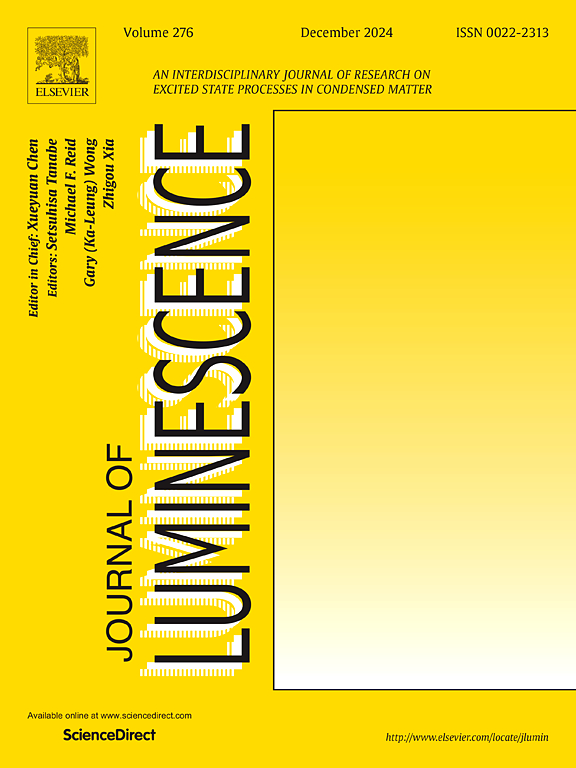Spatiotemporal control of upconversion luminescence through vacancy-induced local structure engineering
IF 3.3
3区 物理与天体物理
Q2 OPTICS
引用次数: 0
Abstract
The escalating proliferation of counterfeit commodities in global markets has emerged as a critical socioeconomic challenge, driving urgent demands for advanced anti-counterfeiting technologies with enhanced security and practicability. Lanthanide-doped upconversion nanoparticles (UCNPs) have demonstrated exceptional potential in fluorescent anti-counterfeiting applications due to their unique anti-Stokes emission characteristics and near-infrared (NIR) excitation capability. Despite significant progress, current multicolor modulation strategies face fundamental limitations including complex doping architectures, inefficient energy transfer, and reliance on multiple excitation wavelengths. This study addresses these challenges through a novel crystal field engineering approach to achieve excitation-responsive color tuning in a simplified single-activator system. We developed a cubic-phase Na0.5YbF3.5:Er/Y@CaF2:Yb nanostructure through precise local crystal field modulation, where strategic adjustment of Na+/F− molar ratios enables remarkable enhancement of red-to-green emission ratios compared to conventional counterparts. The engineered CaF2:Yb sensitization shell effectively suppresses surface-related quenching, resulting in UC enhancement. Crucially, the optimized system demonstrates unprecedented excitation-dependent chromatic switching between green and red emissions through simple laser pulse width modulation under single 980 nm excitation. The unique luminescent properties enable the designed nanocrystals exhibit promising in advanced anti-counterfeiting application. These findings not only overcome existing limitations in multicolor UCNP engineering but also provide fundamental insights into excitation-selective energy transfer mechanisms, with potential extensions to information security and high-resolution bioimaging applications.
基于空位诱导局部结构工程的上转换发光时空控制
假冒商品在全球市场上的不断扩散已成为一项重大的社会经济挑战,促使人们迫切需要具有更高安全性和实用性的先进防伪技术。镧系掺杂上转换纳米粒子(UCNPs)由于其独特的抗斯托克斯发射特性和近红外(NIR)激发能力,在荧光防伪应用中表现出了非凡的潜力。尽管取得了重大进展,但目前的多色调制策略面临着复杂的掺杂结构、低效的能量转移和对多个激发波长的依赖等基本限制。本研究通过一种新颖的晶体场工程方法解决了这些挑战,在简化的单激活剂系统中实现了激励响应的颜色调谐。通过精确的局部晶体场调制,我们开发了一种三相Na0.5YbF3.5:Er/Y@CaF2:Yb纳米结构,其中Na+/F−摩尔比的战略性调整使红绿发射比显著增强。设计的CaF2:Yb敏化壳有效抑制了表面相关的淬火,从而增强了UC。最重要的是,优化后的系统在980 nm单激发下,通过简单的激光脉冲宽度调制,在绿色和红色发射之间实现了前所未有的与激发相关的颜色切换。独特的发光特性使所设计的纳米晶体在先进的防伪应用中具有广阔的应用前景。这些发现不仅克服了多色UCNP工程的现有局限性,而且为激发选择性能量转移机制提供了基本见解,并有可能扩展到信息安全和高分辨率生物成像应用。
本文章由计算机程序翻译,如有差异,请以英文原文为准。
求助全文
约1分钟内获得全文
求助全文
来源期刊

Journal of Luminescence
物理-光学
CiteScore
6.70
自引率
13.90%
发文量
850
审稿时长
3.8 months
期刊介绍:
The purpose of the Journal of Luminescence is to provide a means of communication between scientists in different disciplines who share a common interest in the electronic excited states of molecular, ionic and covalent systems, whether crystalline, amorphous, or liquid.
We invite original papers and reviews on such subjects as: exciton and polariton dynamics, dynamics of localized excited states, energy and charge transport in ordered and disordered systems, radiative and non-radiative recombination, relaxation processes, vibronic interactions in electronic excited states, photochemistry in condensed systems, excited state resonance, double resonance, spin dynamics, selective excitation spectroscopy, hole burning, coherent processes in excited states, (e.g. coherent optical transients, photon echoes, transient gratings), multiphoton processes, optical bistability, photochromism, and new techniques for the study of excited states. This list is not intended to be exhaustive. Papers in the traditional areas of optical spectroscopy (absorption, MCD, luminescence, Raman scattering) are welcome. Papers on applications (phosphors, scintillators, electro- and cathodo-luminescence, radiography, bioimaging, solar energy, energy conversion, etc.) are also welcome if they present results of scientific, rather than only technological interest. However, papers containing purely theoretical results, not related to phenomena in the excited states, as well as papers using luminescence spectroscopy to perform routine analytical chemistry or biochemistry procedures, are outside the scope of the journal. Some exceptions will be possible at the discretion of the editors.
 求助内容:
求助内容: 应助结果提醒方式:
应助结果提醒方式:


